No-deal Brexit: economic implications for Scotland
Illustration of the potential impact that a no-deal Brexit - leaving the EU on the 29th March 2019 without a transition period or agreement on any future trade deal and wider economic relationship - could have on the Scottish economy over the next 12-24 months.
Section 3 - Scotland's Recent Economic Performance and Previous Economic Shocks
Scotland's economy has continued to grow in 2018, continuing a pattern of stronger growth over the past 18 months.
Over the year to 2018Q3, Scotland's economy has grown by 1.3%, broadly in line with the UK and with growth broad based across the Services, Production and Construction sectors. More recent retail sales data show that sales have grown 1.4% in the year to 2018Q4.
Figure 9 - Scottish GDP Growth
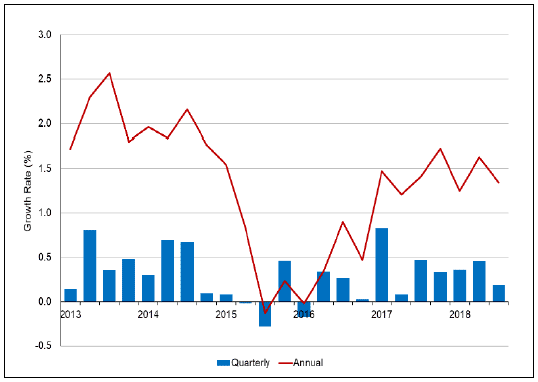
Figure 10 - Scottish Labour Market
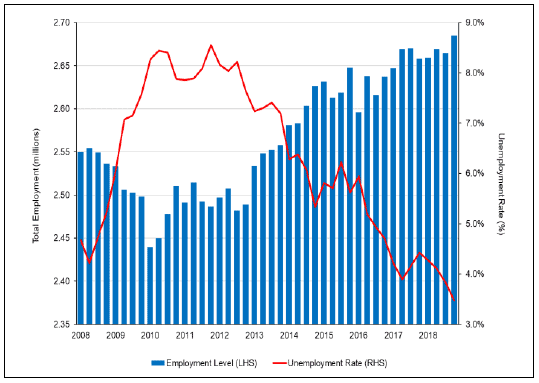
Source: Scottish Government
The stronger output performance has been reflected in the labour market, with figures for October to December 2018 showing unemployment at its lowest rate on record (3.5%) and high employment (75.5%).
Alongside this, the most recent data on productivity, business research and development trends and inward investment underline the expansion of Scotland's economy.
There are a number of drivers underpinning this output growth.
Firstly, stronger global economic growth, combined with the depreciation of sterling have provided a boost to Scottish exports. Scottish exports of goods have increased 6% over the past year in cash terms, meaning that Scotland has seen the fastest rate of export growth of any nation in the UK[8].
Secondly, the rise in the oil price from 2016, coupled with restructuring in the North Sea oil and gas industry, has provided a boost to confidence and activity in the sector. The latest Fraser of Allander Oil and Gas survey[9] shows that the net confidence of oil and gas contractors is at the highest level since spring 2013. This increase in activity directly boosts output in the production and manufacturing sectors in Scotland and feeds through to the wider economy.
Thirdly, Scotland has been successful at attracting Foreign Direct Investment. In 2017, there were 116 new foreign direct investment projects in Scotland - a 7% increase from 2016[10]. Scotland has been the top UK region for FDI, outside London, for five of the past six years. Such investment provides an important source of, often highly skilled, employment.
While Scotland's recent economic performance has been resilient, the shock that a No Deal Brexit could trigger is significant, and there is the potential for economic conditions to change very quickly.
Economic uncertainty is therefore likely to heighten over the coming weeks, leading, in the event of a No Deal Brexit, to a major dislocation to the Scottish economy.
The lack of clarity for Brexit beyond March 2019 is already starting to have an impact on key economic indicators for Scotland.
In the final quarter of 2018, the Scottish Government's Consumer Sentiment Survey fell to its lowest level since the series began in 2013, largely driven by households reporting a negative outlook for the wider economy. Such negative sentiment can feed through to household spending. For example, households may wish to defer large purchases until they feel more secure about the future economic climate.
Figure 11 - Scottish Consumer Sentiment Indicator
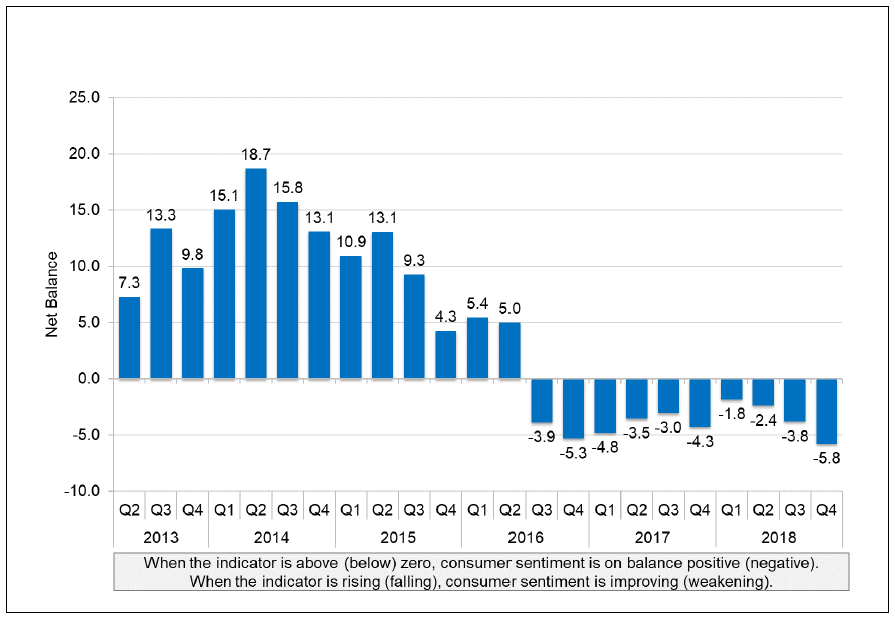
Source: Scottish Government
There are also increasing reports of companies stockpiling key supplies, boosting their cash reserves and reviewing their distribution networks and supply chains in anticipation for future disruption. The IHS Markit/CIPS UK Manufacturing PMI for January reported that business inventory holdings increased at the fastest pace in the 27-year survey history as stockpiling becomes more widespread[11].
As outlined in previous Scottish Government analysis, such stockpiling activity could potentially boost Scottish GDP growth in 2018-19 by up to 0.4 percentage points. However, this would be more than offset by a slowing of output in subsequent quarters. The overall effect of stockpiling on the economy is negative in the medium term[12].
Figure 12 - Illustrative Change in the Growth Rate of Scottish GDP as a result of Stockpiling
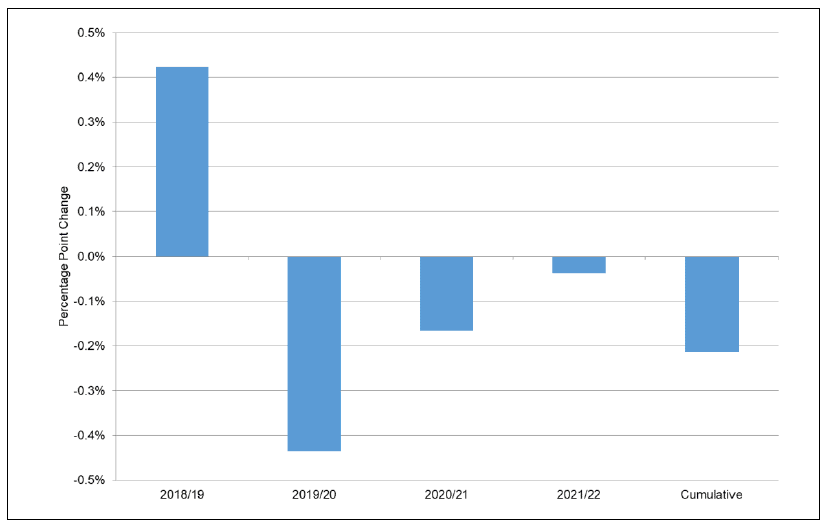
Source: Scottish Government Global Econometric Model. For underpinning analysis please refer to Scottish Government - State of the Economy Report (October 2018)
Previous Economic Shocks
In the event of a No Deal Brexit, Scotland would experience a significant terms-of-trade shock triggered by an immediate change to the legal and regulatory basis of its trade with the EU. This would be expected to manifest into a negative economic shock (collapse in confidence) and present significant logistical challenges for key goods and traded goods.
Whilst there is uncertainty about the potential scale of the shock which Scotland would face, the 2008 Financial Crisis and the 1970s Oil Shock and Three Day Week give an indication of the impact on output and employment when key elements of the economy are significantly impaired. However, in the event of No Deal, the transmission mechanisms for the shock may be different.
In the case of the Financial Crisis, the Scottish economy contracted for a number of quarters and then grew at below its historical trend rate of growth for an extended period. The shock was driven by a collapse in key elements of the financial system which led to banks incurring unprecedented losses, feeding through to a slowdown in bank lending and wider investment. The global nature of the crises compounded the shock and led to a wider slowdown in economic activity.
By the end of 2011, it is estimated that Scottish GDP was approximately 10% below the level that it would have been in the absence of the shock. As a result of this economic slowdown, the number of people unemployed increased by approximately 130,000, there was a large increase in the number of business failures and the UK public finances deteriorated significantly. The impact of the financial crisis is still reflected in the economic data. For example, average Scottish earnings, in real terms, are still below their level in 2008.
Figure 13 - Scottish GDP Index
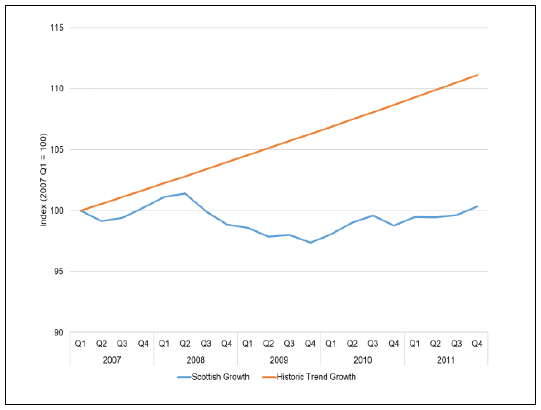
Source: Scottish Government GDP Index. Historic trend is the average growth rate from 1998-2006
Figure 14 - Scottish Unemployment
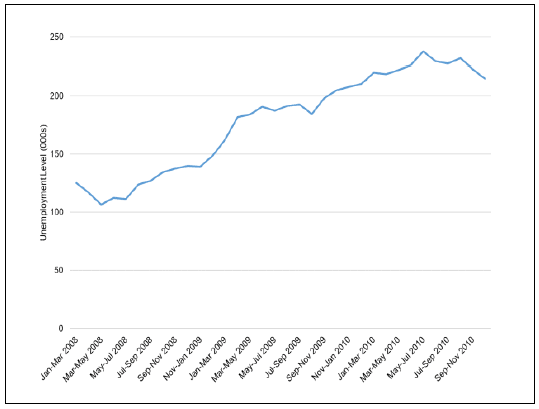
Source: ONS Regional Labour Market Statistics
In the mid-1970s the UK economy faced a series of global economic developments, with the ending of the Bretton Woods system of monetary management and a quadrupling in the oil price following coordinated action by the world's oil producers. These events were compounded by a period of industrial action across many parts of the UK economy, and the temporary introduction of the three-day week.
These pressures led to a significant supply side shock which reduced output across a range of industries. This in turn contributed to a loss of investor confidence in the UK which led to pressure on the Sterling exchange rate and ultimately required the UK Government to seek a loan from the IMF and implement significant reductions in public spending.
These pressures led to a large rise in the cost of living, with inflation peaking at over 26% in 1974 and interest rates rising to 15% in 1976. As a result, UK GDP fell by 5% between 1973 and 1975. In the first quarter of 1974 alone, GDP contracted by 3%.
Figure 15 - RPI Inflation
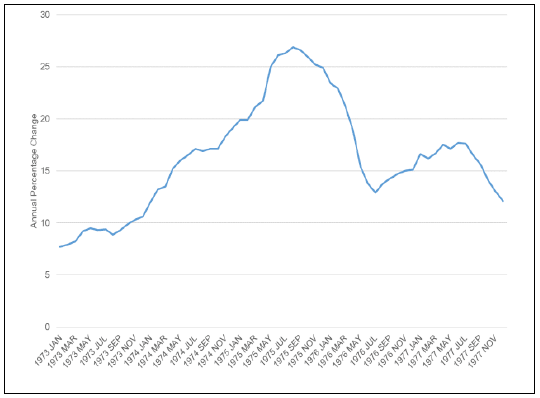
Source: ONS RPI All Items: Percentage change over 12 months
Figure 16 - Interest Rates: Minimum Lending Rate
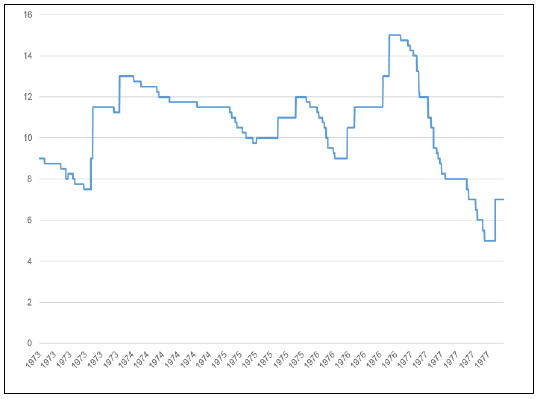
Source: Bank of England Historic Interest Rate Series
Contact
Email: OCEABusiness@gov.scot
There is a problem
Thanks for your feedback